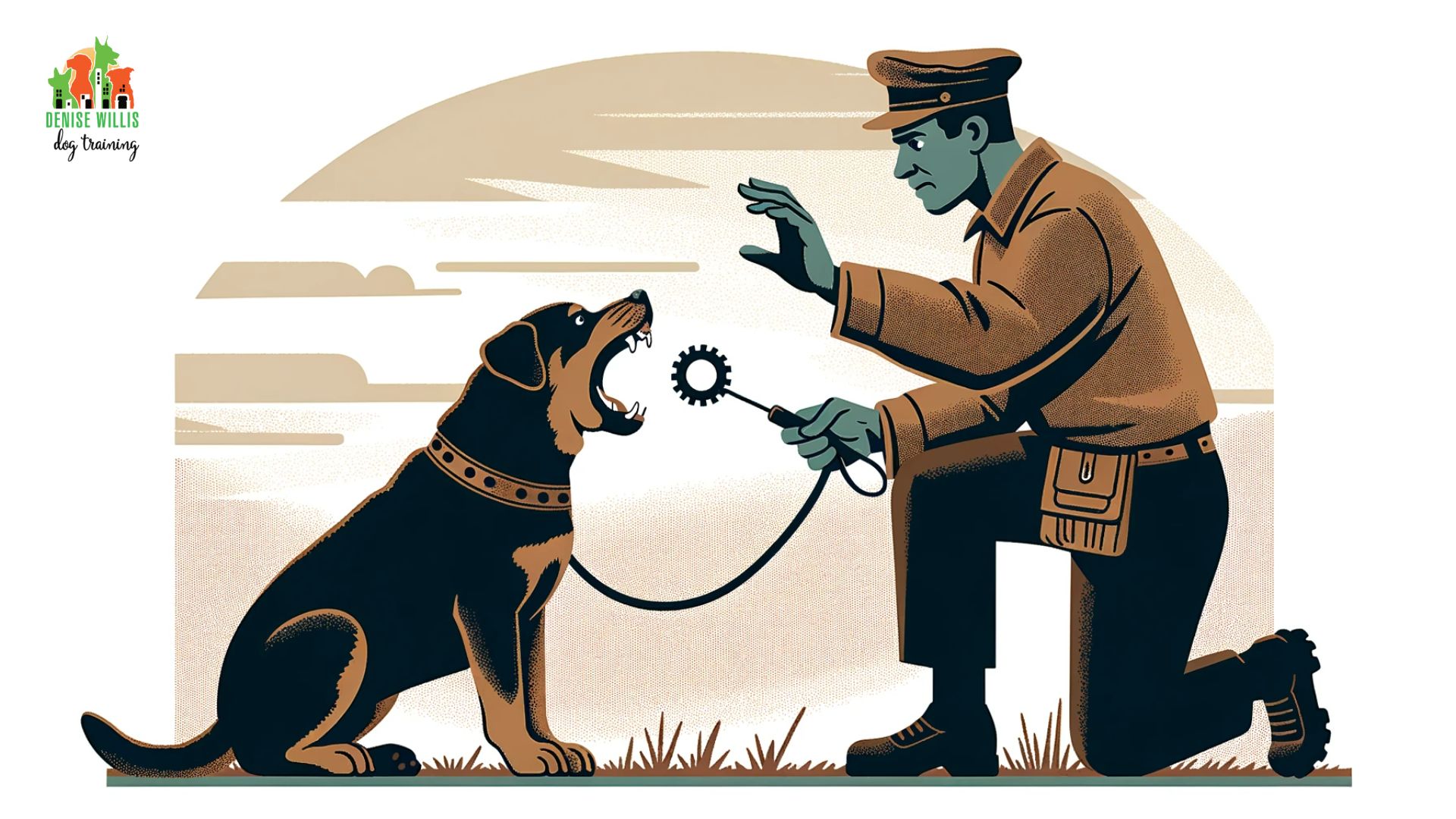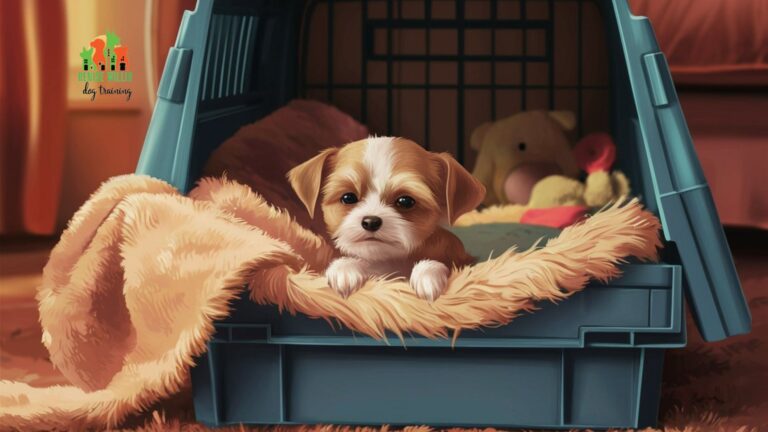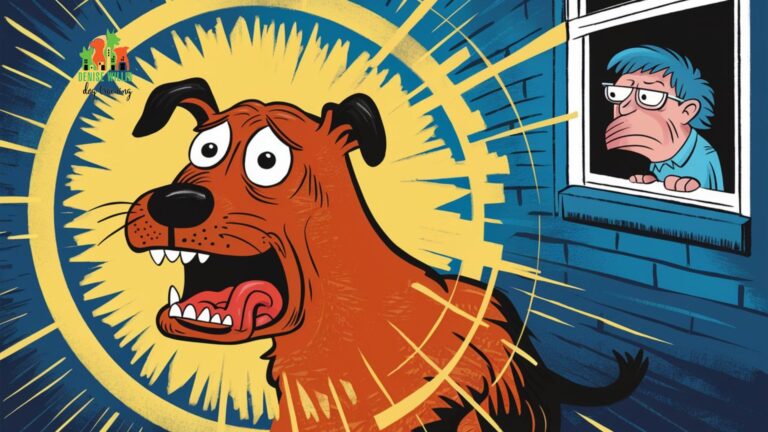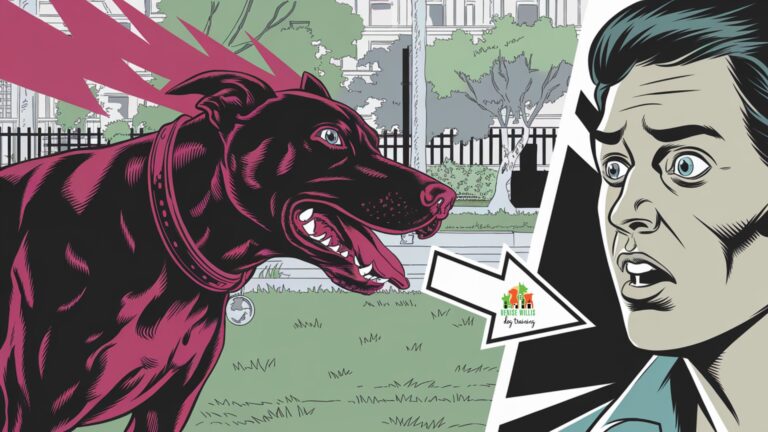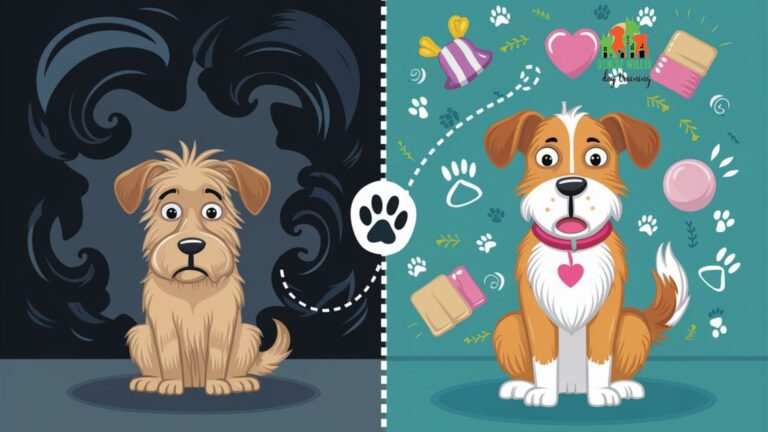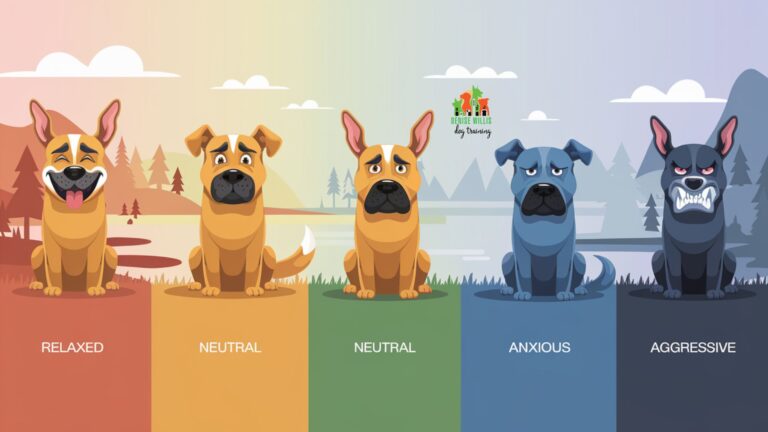Training Aggressive Rescue Dogs: Mastering the Art of Gentle Control
📍 Service Area Notice: DW Dog Training provides in-person training services exclusively in the Greater Baltimore area. While our blog content is designed to help dog owners internationally, our hands-on training services are locally focused. For readers outside our service area, we hope you find value in our articles and welcome you to reach out with questions!
Successfully training rescued dogs displaying aggression issues is incredibly important for improving public safety, enhancing adoptability, and providing dogs the ability to live fulfilled lives in forever homes. Aggressive behaviors left unchecked can escalate over time and lead to tragic outcomes for dogs and humans alike. Proper rehabilitation helps curb concerning behaviors in at-risk shelter dogs, allowing more to find loving families rather than face euthanasia. With compassion and diligence, the prognosis for aggressive rescue dogs can often be quite positive. But customized behavior modification facilitated by accredited professionals is crucial.
Many rescued dogs arrive at shelters exhibiting anxiety, fearfulness, guarding tendencies, or outright aggression due to lack of socialization, previous abuse, medical factors, or survival instincts developed while living on the streets. Warning behaviors like growling, lunging, snapping, and biting often stem from fear or perceived threats. Without intervention, aggressive habits typically intensify, which can make dogs unadoptable. Tragically, aggression issues also contribute to high return rates once adopted. However, research shows that implementing customized positive reinforcement-based training programs significantly improves aggressive rescue dogs’ chances of living harmoniously in forever homes.
Successfully rehabilitating aggressive rescued dogs requires a multi-pronged approach incorporating:
- Systematic desensitization and counterconditioning to change negative associations
- Customized behavior modification plans using force-free methods
- Medical exams and potential prescription of anti-anxiety medication
- Enrichment and routine to reduce stress
- Management via crates, gates, and leashes to prevent rehearsing concerning behaviors
- Ongoing support from accredited professionals like certified applied animal behavior consultants, veterinary behaviorists, and positive reinforcement trainers
- Realistic expectations regarding required lifelong diligence and supervision
With hard work, lifestyle adaptations, and skilled guidance applied consistently over an extensive timeframe, many aggressive rescue dogs can substantially improve. But human safety must remain the priority, and some dogs still require permanent separation or rehoming after exhaustive efforts. Ultimately, specialized training programs give aggressive dogs their best chance while prioritizing protection for adopters and communities.
Key Takeaways on Training Aggressive Rescue Dogs
- Dog aggression encompasses behaviors like growling, lunging, or biting used to threaten or harm due to fear, territoriality, or other factors.
- Lack of socialization, fear of unpredictable behaviors, possession guarding, and high prey drive can prompt aggression toward people.
- Small children are especially vulnerable to bites due to their size, erratic behaviors, and inability to read dogs’ warning signals.
- Warning signs include subtle body language cues like lip licking as well as overt threats like baring teeth and snarling.
- Do not punish warning signs, as this can increase bite risk. Separate child and dog at the first hint of odd behavior.
- Proper socialization, training, supervision, and environment management are key to prevention.
- Immediately consult accredited professionals if any aggression arises. Customized behavior modification is crucial.
- With guidance, patience, realistic expectations, and diligent lifelong management, aggressive dogs often can improve and coexist safely.
- But some dogs remain unreliable around very young or unpredictable kids, requiring permanent separation.
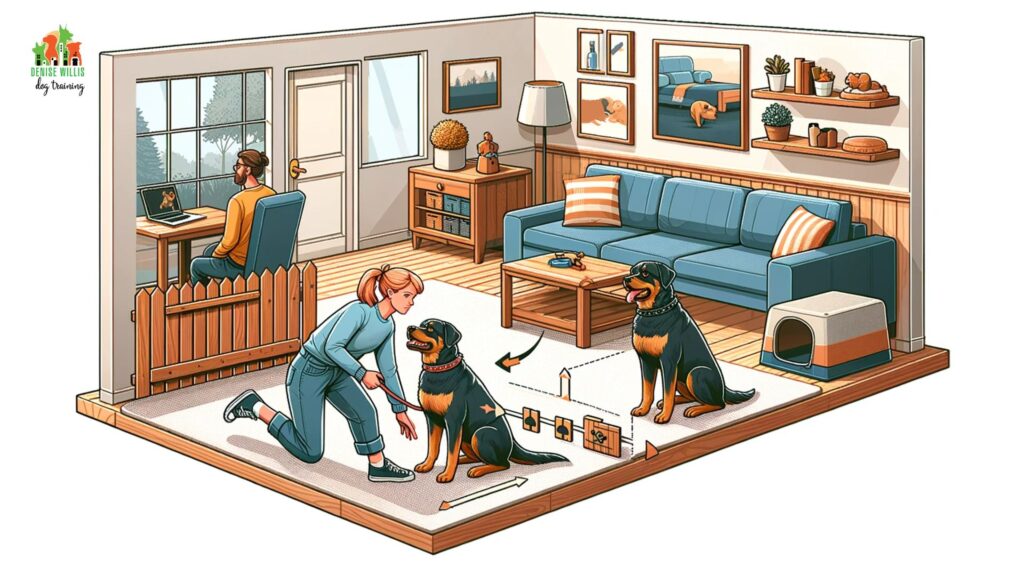
Understanding Aggression in Rescue Dogs
Aggression in rescue dogs frequently arises from stressful past experiences that led to the development of anxious or defensive behaviors. Being aware of key factors that commonly prompt and reinforce aggressive tendencies can provide insight into the root causes to target through socialization, desensitization, training, and medical care.
Common Causes of Aggression in Rescue Dogs
Aggression in rescued dogs frequently stems from unfortunate prior life experiences that necessitated using defensive behaviors for survival. Common causes leading to anxious or aggressive habits include:
- Lack of socialization: Undersocialized dogs often view normal interactions as threatening due to unfamiliarity. Puppies require extensive positive exposures to people, places, and handling during critical developmental stages. Rescues often miss this, prompting fear-based reactivity.
- Abuse or neglect: Harsh physical or verbal punishment can make dogs defensive. Painful experiences lead to associations between human interactions and fear. Abused dogs may react protectively to avoid anticipated punishments.
- Medical factors: Illness, injury, neurological issues, anxiety disorders, and pain can all lower a dog’s bite threshold and tolerance for stimulation. Irritability prompts reactive warning displays or bites.
- Survival instincts: Dogs previously living on streets in a constant fight for resources may use aggression to guard food, territory, and themselves. These protective habits often continue post-rescue.
- Dominance: Some assertive dogs may attempt to vie for the top position in a new home using aggression, especially if they received inconsistent leadership previously.
Table 1: Common Triggers Prompting Aggressive Responses in Rescue Dogs
| Category | Specific Triggers | Signs of Distress |
| Environment | Construction noises, guests in home, loud noises, changes in routine | Barking, growling, pacing, hiding |
| Health | Pain, illness, medication side effects, cognitive decline, nutritional deficiencies | Irritability, sensitivity to touch, lethargy, disorientation |
| Social | Unfamiliar people, new baby at home, restraint, proximity to other dogs | Stiffening, whale eye, teeth baring, lunging |
Types of Aggression Seen in Rescued Dogs
Aggression displays in rescued dogs generally fall into several major categories based on the underlying motivation and context. Being aware of the different classifications of aggression helps owners and professionals identify patterns and determine the most effective behavior modification approaches.
Common Aggression Classifications in Rescue Dogs
- Territorial aggression
- Possessive aggression
- Fear-based aggression
- Predatory aggression
- Dominance aggression
- Redirected aggression
The specific classification of aggression displayed in a dog provides insight into motivations. A dog lunging at passersby on walks likely exhibits territorial aggression, while resource-guarding toys or food points to possessive aggression. Identifying the type helps behaviorists design appropriate modification protocols targeting the root cause.
Table 2: Aggression Classifications, Motivations and Behavior in Rescued Dogs
| Aggression Type | Motivation | Behaviors |
| Territorial | Guarding property/space | Lunging at fences, door charging, biting intruders |
| Possessive | Guarding resources | Food bowl guarding, toy guarding, stiffness when approached |
| Fear-based | Self-protection | Defensive biting, hiding, urinating |
| Predatory | Hunting instinct | Stalking, chasing, mouthing |
| Dominance | Establishing rank | Staring, mounting, rough play |
| Redirected | Displaced reactivity | Biting handler when restrained from other dog |
Recognizing Warning Signs of Aggression
Rescued dogs typically progress through escalating body language signals prior to actual biting or attacks unless taken by complete surprise. Paying close attention helps catch issues early before harm occurs.
Early subtle signs:
- Yawning, lip licking, averting gaze
- Freezing, sudden stillness
- Low tail or ears
More overt threats:
- Baring teeth, growling
- Raising hackles along the back
- Snapping jaws
- Lunging forward
Catching the earliest signals like lip licking and avoiding eye contact enables early intervention before reactivity progresses to snapping or biting. Separate dog and perceived threat at the first hint of odd behavior.
Table 3: Professional Options for Treating Dog Aggression
| Role | Evaluation | Treatment Planning | Ongoing Support |
| Certified Trainer | Identify triggers | Positive reinforcement protocols | Accountability & troubleshooting |
| Veterinary Behaviorist | Medical exams | Prescribe medication | Medication monitoring & adjustment |
| Behavior Consultant | Assess motivation | Counterconditioning programs | Coaching & coordination of care |
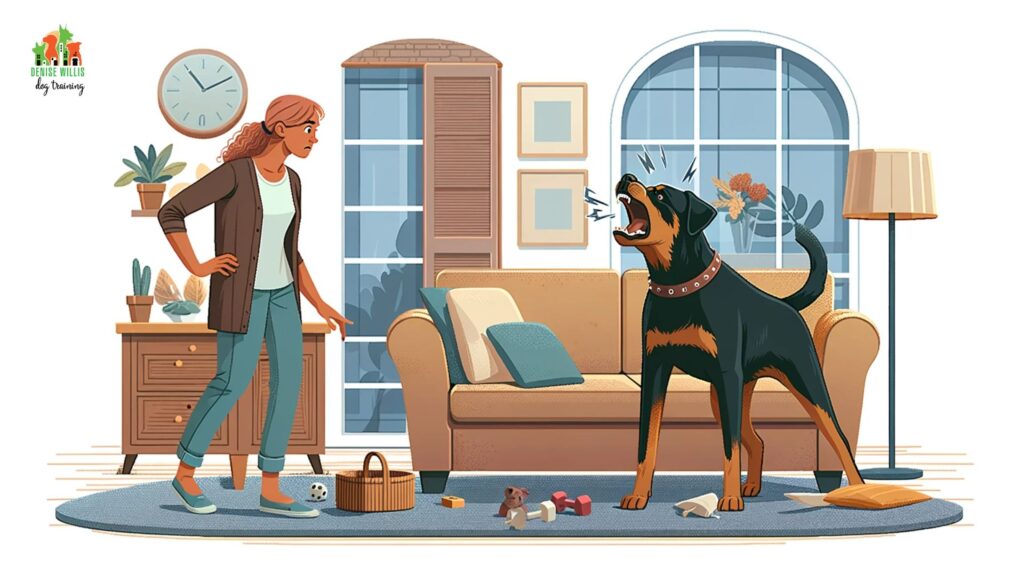
Safety First When Managing an Aggressive Rescue Dog
Bringing an aggressive dog into your home presents inherent risks. However, implementing temporary safeguards can help provide protection while allowing ongoing rehabilitation through positive methods. Taking steps to prioritize safety for your family and the dog during the transition period is essential.
Prioritizing Human and Animal Safety
When bringing an aggressive rescued dog into your home, implementing precautions to prevent harm is paramount. While counterconditioning and training will be ongoing, safety protocols ensure risky situations are avoided in the short term. Preventing the rehearsal of concerning behaviors through supervision, confinement, and physical management helps minimize opportunities for bites while rehabilitation occurs. Patience and compassion must be balanced with sensible precautions.
Use of Proper Equipment
Basket-style muzzles allow dogs to pant, drink, and take treats while preventing bites during training, introductions, or emergencies. Crates and baby gates provide confinement when unsupervised. Martingale collars and front-clip harnesses give extra control during handling and walks. Such tools keep humans and animals safe without using pain or punishment. Introduce equipment gradually with positive reinforcement.
Isolation from Triggers
Rotating dogs and family members through separate areas prevents uncontrolled interactions with aggression triggers. Confine dogs when children or guests are present. Crate or leash when outdoors or when the family is home. Gate off rooms. Supervise directly if allowed together. The goal is to avoid behaviors like resource guarding or fear-based biting while modifying the underlying emotions through training.
Professional Guidance for Severe Cases
For dogs displaying dangerous levels of aggression not improving with management, seeking guidance from both accredited dog trainers and veterinary behaviorists is imperative. They can provide safety consulting, prescribe anxiety medications, design customized treatment protocols, and determine if rehoming may be warranted after exhaustive efforts. Do not attempt severe aggression cases without professional support.
Consider Rehoming If Aggression Remains Dangerous
In worst-case scenarios, a dog may remain unreliable despite extensive training and be a substantial danger to household members. If all options have been exhausted under the guidance of professionals, rehoming to an adult-only home or shelter may be considered. However, this decision should involve your consulting experts. Rehoming surrenders should go through proper channels. Euthanasia should always be an absolute last resort for severely aggressive dogs, as rehoming provides a chance to start fresh with comprehensive training. Still, lifelong management will likely be required.
Table 4: Escalation Stages of Aggressive Responses in Rescue Dogs
| Stage | Signals | Actions to Take |
| 1 | Lip licking, yawning, averting gaze | Note signals, record details |
| 2 | Growling, piloerection, tense posture | Create more space, use barriers |
| 3 | Lunging, snapping, barking | Urgently remove from situation |
| 4 | Biting, attacking | Immediately consult professionals |
Training Techniques for Aggressive Rescue Dogs
Successfully rehabilitating aggressive rescue dogs requires implementing customized training protocols focused on reinforcing desirable behaviors and changing emotional responses to triggers.
Positive Reinforcement
Force-free positive reinforcement training is essential for aggressive rescue dogs to rebuild trust, change negative associations, and teach appropriate behaviors. Reward desired actions with high-value treats, praise, toys, and access to pleasant activities. Set dogs up for success in controlled scenarios. Saying “Good boy!” and giving a treat when a dog remains calm seeing a stranger rather than reacting teaches self-control. Rewards motivate learning without using punishment or pain.
Systematic Desensitization and Counterconditioning
Desensitization techniques gradually expose dogs to triggering stimuli at low enough levels to prevent reactive responses. Over many sessions, the intensity is increased as the dog remains relaxed. For example, a dog reactive to men could start training with a man simply in view. Reward calm behavior, then slowly bring the man closer over multiple days.
Counterconditioning uses positive associations to change a dog’s emotional response to a trigger. For instance, pairing tasty treats with the sight of strangers teaches the dog children to predict good things rather than cause anxiety. Desirable conduct is marked and reinforced.
Obedience Training and Impulse Control
Rescued dogs benefit tremendously from basic obedience training to strengthen listening skills. Impulse control exercises teach patience and self-regulation. Having dogs practice “Look,” “Leave it,” “Sit,” and “Stay” around triggers but at a safe distance trains focus while preventing reaction opportunities. Freeze games build waiting skills. Obedience helps make dogs more receptive to behavior modification protocols.
Potential Prescription of Anxiety Medications
In some cases, medication prescribed by a veterinary behaviorist can provide useful temporary support during training. Anti-anxiety medications like fluoxetine help take the edge off a dog’s reactivity, enabling improved attention and less emotional responses during behavior modification sessions. Any medication is tapered once improvement occurs. Veterinary supervision ensures protocols maximize progress.
Socialization and Confidence Building
Creating positive experiences in a controlled setting allows aggressive rescue dogs to become comfortable with people, places, sounds, and handling that previously caused anxiety. Socialization must be gradual, pairing pleasant things with triggers. Confidence-building activities like obedience work, agility, or nosework teach dogs to look to their handler for support when overwhelmed rather than reacting defensively. Fun, enriching activities condition optimism and trust.
Providing Adequate Exercise and Enrichment
Physical and mental exercise is key to lowering aggressive tendencies by reducing pent-up energy. Long decompression walks, games of fetch, and access to a yard allow dogs to run off stress hormones. Enrichment like food puzzles, chew toys, and lick mats keeps dogs happily engaged. A tired dog with an enriched environment has less frustration and arousal contributing to aggressive reactions. Structured daily routines also provide stability.
Managing and Living with an Aggressive Rescue Dog
Adopting an aggressive rescue dog requires adaptations to your daily routines and environment to help set your dog up for rehabilitation success. Implementing prudent management precautions and handling dogs with compassion can go a long way toward reducing concerning behaviors during the transition period and beyond.
Identifying and Avoiding Triggers
Carefully observing the contexts where your dog displays concerning behaviors allows you to identify specific triggers. Keeping a detailed log of incidents can uncover patterns. Does your dog only growl when a stranger approaches the front door or when children run by the yard? Does guarding only happen with a certain toy or around the food bowl? Pinpointing the stimuli prompting aggression allows you to proactively avoid those situations while conducting training. Preventing the rehearsal of problem behaviors is key.
Utilizing Rotated Separation
To provide safety yet optimize quality of life during the transition period, consider keeping family members and your dog separated on a rotating schedule. Use baby gates to compartmentalize your home. For instance, when you are cooking in the kitchen, the dog stays gated in the living room with a puzzle feeder. When the kids do homework, the dog enjoys a chew in the yard. Taking turns helps avoid problems like food guarding or fear-based territoriality until training progresses.
Adjusting Walks and Yard Time
Escape-proof fencing is essential if your yard is used for dog relief or play. During walks, consider an early morning or late-night schedule when fewer people are out to prevent leash reactivity. Avoiding crowded parks or trails reduces overstimulation and greeting behaviors that could trigger possessive aggression. Focus walks on training using high-value treats to reinforce attention on you rather than potential triggers.
Lifelong Management is Often Necessary
While aggressive behavior can improve substantially with customized training, some level of lifelong management is typically prudent for dogs with a bite history. Be realistic – a dog aggressive to strangers may never be reliable at busy parks. But with diligence, they can learn to walk nicely on a leash past people. Permanent separation around children could be needed. Expect setbacks during training requiring further adjustments. Responsible management optimizes safety and welfare.
Maintaining Realistic Expectations
When adopting an aggressive rescue dog, expect rehabilitation to be slow with occasional regression. Improvement happens incrementally over an extensive period. Medical issues could arise complicating progress. Some dogs may remain unreliable in certain contexts requiring supervision. But management paired with compassion and positive training helps dogs with aggressive pasts thrive. Celebrate small successes. And, contact your professional support team if you encounter hurdles. Realistic outlooks better prepare you for the challenges.

Preventing Aggression in Rescue Dogs
While managing existing aggression in adopted rescue dogs is challenging, focusing on prevention can help decrease cases long-term. Employing proven techniques focused on socialization, humane handling, training, and sensible vetting practices allows dogs the opportunity to develop appropriate social skills and coping mechanisms, reducing the likelihood of problematic aggression.
Early Socialization as Puppies
Preventing the development of anxiety and aggression starts with proper socialization as puppies. Early positive exposures to handling, environments, people, and dogs during the critical developmental stage between 6-16 weeks help puppies become confident, well-adjusted adult dogs. Carefully controlled introductions avoiding overstimulation paired with rewards for calm responses are key. Enroll in structured puppy socialization classes for best results.
Utilizing Humane Reward-Based Training
Force-free positive reinforcement training methods are essential for prevention. Harsh physical or verbal punishment can contribute to anxiety and defensiveness. Reward desired behaviors to strengthen communication and trust. Incorporate impulse control games and enrichment. Establish leadership through fair structure and meeting a dog’s needs. Proactively addressing potential behavior issues through compassionate training prevents escalation.
Careful Vetting Prior to Rescue Adoption
Shelters and rescues have a responsibility to thoroughly assess dogs in their care to avoid adopting out animals with dangerous aggression levels. Dogs with concerning histories should be foster tested extensively around strangers, kids, and other dogs prior to adoption. Rescues should invest in professional behavioral evaluations to determine if rehabilitation prior to rehoming may be feasible or if euthanasia is warranted for certain cases. Ethics demand honesty about issues.
Advocating Against Punitive Methods
Harsh handling and training techniques often contribute to anxious, reactive, and aggressive behaviors in dogs. Advocating force-free methods helps protect the welfare of dogs. Support rescues utilizing positive reinforcement protocols. If you witness mistreatment, politely intervene and educate when feasible. Reporting extreme cases to authorities helps prevent abuse. Collectively raising standards improves outcomes for countless dogs.
Final Thoughts
Successfully managing and improving aggression in a rescue dog requires a multi-faceted approach and long-term commitment. With realistic expectations, lifestyle adaptations, skilled guidance, and diligent implementation of customized training protocols, many dogs can learn to happily coexist after rehabilitation. However, human and animal well-being must always come first.
Summary of Dog Aggression Training Techniques
Successfully rehabilitating aggressive rescue dogs requires implementing customized training protocols focused on reinforcing desirable behaviors and changing emotional responses to triggers. Force-free techniques like systematic desensitization, counterconditioning, confidence building, impulse control exercises, and positive reinforcement are essential. Management via rotated separation, crates, and gates prevents rehearsing problem behaviors during the transition period. With diligence, compassion, lifestyle adaptations, and acute attention to safety, improvement is often achieved. But some dogs require lifelong supervision or permanent separation.
Aggression Often Stems From Past Trauma
Rescue dogs frequently develop reactive and aggressive habits like resource guarding, fear-based territoriality, or leash reactivity due to mistreatment, lack of socialization, negative experiences, or survival instincts. But their problematic behaviors commonly stem from unhealthy environmental factors rather than innate aggression. With structure, predictability, training, and TLC, many anxious dogs become happier and better adjusted. However, responsible management remains necessary long-term for certain individuals.
With Patience, Aggression Can Improve
Rehabilitating an aggressive dog mandates tremendous patience, compassion, diligence, and lifestyle adaptations. But by utilizing positive reinforcement, desensitization, impulse control, customized protocols, medication if needed, and enrichment, dogs often make significant progress in lowering reactivity given sufficient time and consistency. Accredited professionals like those at DW Dog Training can help guide rehabilitation safely. While some problematic behaviors may persist requiring caution, many dogs learn to successfully coexist in families and communities once again thanks to dedicated owners.
Human and Animal Safety Are Paramount
Humans’ and dogs’ physical and emotional well-being should remain the top priority when managing rescue dog aggression issues. While counterconditioning aims to improve behavior long-term, short-term precautions like secured gates, containment, supervision, proper equipment, and separated spaces serve to keep all family members safe. Consult professionals immediately if aggression arises, as prompt intervention leads to better outcomes. Some dogs prove unreliable around children or strangers necessitating rehoming. When faced with aggression, compassion and prudence together pave the path for peaceful coexistence.
Don’t Delay – Get Help From DW Dog Training Today
The experts at DW Dog Training can help create customized training plans to rehabilitate your aggressive rescue dog and establish long-term harmony. Contact us today for specialized evaluations and positive behavior modification protocols. With diligence and realistic expectations, we can help your dog overcome anxiety and reactivity to safely enjoy their new life. But safety comes first – permanent separation may still be required in certain unrelenting cases. Swiftly addressing concerning behaviors leads to the best prognosis. We offer experience, expertise guidance, and ongoing support – your personalized solution starts now.

